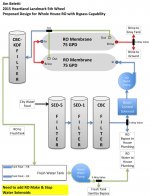A friend of mine just installed an inexpensive ($131 from Lowes - link) R.O. system in his Jayco Pinnacle. He loves the water that comes out of it. He uses it for drinking water only - so he uses a small steel pressurized storage tank (the one that came with the system).
My Ice Maker has been winterized the past 2 months we've been on the road and we've been buying ice and going through a case of bottled water a week, plus a couple gallons of purchased drinking water for the dogs.
I am currently running two whole-house water filters (stage 1: 5 micron sediment / stage 2: carbon). The refer has its own filter, which is currently removed as part of the winterization process, but when installed, that's a 3rd filter in the system for water we get from the refer water dispenser and the ice maker.
This all said, I want to clean up the campground water even more, but just for:
I've used these two sites as my research resource:
- RV Water Filter Store
- Pure Water Products
If I do this, I will not purchase one of the full-pre-made RO systems. I'll buy items piecemeal so I can integrate my existing whole-house filter housings*. At the output of stage 2 of my filtration system, I'll feed the RO membrane, then an RO post-filter (carbon block filter for chlorine/chemical reduction and taste/odor improvement) and then into an RO tank (small pressurized steel tank). From the tank, I'll feed a counter-mounted drinking water tap and the refer ice maker line.
My plan is to co-locate the RO items with my existing filters, behind the utility wall (water pump / water heater / furnace area).
I know two RVers (motorhomes) that create a LOT of RO water and store it in their coach fresh water tank and draw from that with the coach water pump. I have no need for that much RO water and have no plans to make and store that much. As such, my fresh water tank and water pump will not be involved in my RO strategy.
So...
* RO systems that use the larger, whole-house size filter housings before the RO membrane, are optimized for 1/4" or 3/8" lines for the demand of RO product water needs. My existing whole-house filter housings are fed by 1/2" PEX and use 1/2" PEX at the output. I feel this is best for my whole-coach water needs, so I want to keep these filter housings. I also do not want a duplicate set of filters/housings for RO. Just no need. This is why I will keep my current filters/housings and split the output to feed the coach and feed the RO membrane.
My Ice Maker has been winterized the past 2 months we've been on the road and we've been buying ice and going through a case of bottled water a week, plus a couple gallons of purchased drinking water for the dogs.
I am currently running two whole-house water filters (stage 1: 5 micron sediment / stage 2: carbon). The refer has its own filter, which is currently removed as part of the winterization process, but when installed, that's a 3rd filter in the system for water we get from the refer water dispenser and the ice maker.
This all said, I want to clean up the campground water even more, but just for:
- Drinking water (people and dogs)
- Ice making
- Cooking (but not coffee making)
- CPAP machines (vs purchased distilled water)
I've used these two sites as my research resource:
- RV Water Filter Store
- Pure Water Products
If I do this, I will not purchase one of the full-pre-made RO systems. I'll buy items piecemeal so I can integrate my existing whole-house filter housings*. At the output of stage 2 of my filtration system, I'll feed the RO membrane, then an RO post-filter (carbon block filter for chlorine/chemical reduction and taste/odor improvement) and then into an RO tank (small pressurized steel tank). From the tank, I'll feed a counter-mounted drinking water tap and the refer ice maker line.
My plan is to co-locate the RO items with my existing filters, behind the utility wall (water pump / water heater / furnace area).
I know two RVers (motorhomes) that create a LOT of RO water and store it in their coach fresh water tank and draw from that with the coach water pump. I have no need for that much RO water and have no plans to make and store that much. As such, my fresh water tank and water pump will not be involved in my RO strategy.
So...
- Who's using RO in their coach now?
- What all do you use RO water for?
- How is your system working out for you?
- What would you do differently if you were to tweak your RO system?
* RO systems that use the larger, whole-house size filter housings before the RO membrane, are optimized for 1/4" or 3/8" lines for the demand of RO product water needs. My existing whole-house filter housings are fed by 1/2" PEX and use 1/2" PEX at the output. I feel this is best for my whole-coach water needs, so I want to keep these filter housings. I also do not want a duplicate set of filters/housings for RO. Just no need. This is why I will keep my current filters/housings and split the output to feed the coach and feed the RO membrane.

